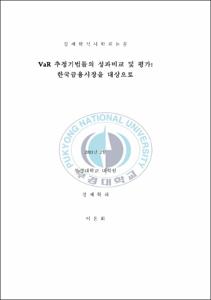VaR 추정기법들의 성과비교 및 평가: 한국금융시장을 대상으로
- Alternative Title
- Evaluation and comparison on VaR Estimation Methods: Focusing on Korean Financial Market
- Abstract
- Evaluation and comparison on VaR Estimation Methods: Focusing on Korean Financial Market
Don Hwa Lee
Department of Economics, Graduate School,
Pukyong National University
Abstract
The crisis started in 2007 to manage the global financial crisis increased the importance. As a result, many financial institutions became concerned about the Value-at-Risk.
Value-at-Risk is conceptual simple and ease of use. Therefore, International financial institutions are commonly using method of risk management.
Value-at-Risk summarizes maximum possible amount of loss for a specified period in normal market conditions, Estimation methods are parametric method under normal distribution and non-parametric method under not normal distribution.
The main purpose of this study is to explain basic concept of Value-at-Risk and discusses various estimation methods(Delta-Normal Method, Historical Simulation Method, MonteCarlo Simulation Method, G and H Method). In addition to parametric and non-parametric methods are compared. Also, An alternative to existing methods of Value-at-Risk, I proposes a new method that is based on Tukey's G-and-H distribution.
Delta-Normal Method is assumed Normal distribution in probability distribution of returns, Parametic methods are called. Delta-Normal Method, when estimating VaR, volatility is an important factor. Methods for measuring volatility, historical standard deviation method, EWMA method, GARCH(1,1) was used. Non-parametric methods were used Historical simulation and Monte Carlo simulation methods. G-and-H Method, distributional assumption is especially useful if asymmetries and fatter tails have to be considered and fast simulation from the model is of importance.
To compare these methods, Value-at-Risk is calculated in confidence level to 95%, 99% using data of close-to-close return of KOSPI 200 and 3-year Government bonds. And sample period is January 2, 2007 to December 31, 2009. And method of back-testing was conducted Failure Ratio(FR) and Z-score test.
Keywords : Value-at-Risk, Delta-Normal Value-at-Risk, Montecarlo simulation, Historical simulation, G and H distribution, skewness-kurtosis, risk measurement, distribution fitting.
- Issued Date
- 2011
- Awarded Date
- 2011. 2
- Type
- Dissertation
- Keyword
- Value-at-Risk G and H distribution Delta-Normal Value-at-Risk Montecarlo simulation Historical simulation skewness-kurtosis risk measurement distribution fitting
- Publisher
- 부경대학교
- Affiliation
- 부경대학교 일반대학원 경제학과
- Department
- 대학원 경제학과
- Advisor
- 장병기
- Table Of Contents
- 제1장 서론 1
제1절 연구의 목적 및 의의 1
제2절 연구의 방법 및 구성 2
제2장 선행연구 4
제3장 VaR의 개념과 추정방법 8
제1절 VaR의 기본개념 8
1. VaR의 정의 8
2. VaR의 역할 9
제2절 전통적 VaR 추정방법 10
1. 델타-노말 방법 10
2. 역사적 시뮬레이션 방법 16
3. 몬테카를로 시뮬레이션 방법 18
제3절 G and H 분포를 이용한 VaR 추정방법 24
1. G and H 분포의 속성 24
2. 파라미터 추정절차 26
제4절 사후검증 29
제4장 실증분석 32
제1절 자료의 선정 및 기초통계량 32
1. 자료의 선정 32
2. 기초통계량 33
제2절 델타-노말 방법에 의한 VaR 추정 35
1. 역사적 표준편차 방법 35
2. 지수가중이동평균(EWMA) 방법 38
3. GARCH(1,1) 방법 40
제3절 역사적 시뮬레이션 방법에 의한 VaR 추정 43
제4절 몬테카를로 시뮬레이션 방법에 의한 VaR 추정 46
제5절 G and H 분포를 이용한 VaR 추정 49
제6절 성과비교 53
제4장 결론 62
제1절 연구 결과 및 의의 62
제2절 한계점 및 향후 연구방향 65
참고 문헌 67
부록 70
- Degree
- Master
- Files in This Item:
-
-
Download
 VaR 추정기법들의 성과비교 및 평가: 한국금융시장을 대상으로.pdf
기타 데이터 / 828.2 kB / Adobe PDF
VaR 추정기법들의 성과비교 및 평가: 한국금융시장을 대상으로.pdf
기타 데이터 / 828.2 kB / Adobe PDF
-
Items in Repository are protected by copyright, with all rights reserved, unless otherwise indicated.